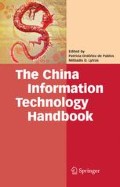Abstract
This chapter explores and analyses patterns in international manufacturing strategies, based on data from the Fourth International Manufacturing Strategy Survey (IMSS), conducted in 2005. Based on a principal components analysis a selection of the thirty-one most important contributing variables from the IMSS dataset is made, and a self-organizing map (SOM) is used to cluster manufacturing companies according to their strategy, performance, manufacturing and supply-chain practices, and improvement programs. The clusters of companies and patterns of strategies are analyzed and discussed. Special attention is attached to differences between countries. The results reveal four groups (types) of companies: low supply-chain integration companies; integrated supply-chain companies; mass production, high tech companies; and production-oriented low tech companies.
Access this chapter
Tax calculation will be finalised at checkout
Purchases are for personal use only
References
Back B, Oosterom G, Sere K, van Wezel M. (1995) Intelligent information systems within business: bankruptcy predictions using neural networks. In: Doukidis G, Galliers R, Jelassi T, Krcmar H, Land F (eds) Proceedings of the Third European Conference on Information Systems ECIS '95, Athens, Greece, June 1-3, 1995:99-112
Back B, Sere K, Vanharanta H (1998) Managing complexity in large data bases using self-organizing maps. Account Manag Inform Tech 8:191-210
Charalambous C, Hadjinicola GC, Muller E (2001) Product positioning using principles from the self-organizing map. Lecture Notes In Computer Science, Vol. 2130: Proceedings of the International Conference on Artificial Neural Networks, Vienna, Austria. Springer-Verlag , London:457-463
Chen D-R, Chang R-F, Huang Y-L (2000) Breast Cancer Diagnosis Using Self-Organizing Map for Sonography. Ultrasound Med Biol 26(3):405-411
Costea A, Kloptchenko A, Back B (2004) Analyzing Economical Performance of Central-East-European Countries Using Neural Networks and Cluster Analysis. In: Proceedings of the Fifth International Symposium on Economic Informatics, May, Bucharest, Rumania. Editura Inforec, Bucharest:1006-1011
Eklund T, Back B, Vanharanta H, Visa A (2003). Using the self-organizing map as a visualization tool in financial benchmarking. Inform Visual 2(3):171-181
Frolich MT (2002) Techniques for improving response rate in OM surveys. J Oper Manag 20:53-62
Kasabov N, Deng D, Erzegovezi L, Fedrizzi M, Beber A (2000). Hybrid Intelligent Decision Support Systems for Risk Analysis and Prediction of Evolving Economic Clusters in Europe. In: Kasabov N (ed) Future Directions for Intelligent Information Systems and Information Sciences. Springer Verlag, Heidelberg
Kaski S, Kohonen T (1996) Exploratory Data Analysis by the Self-Organizing Map: Structures of Welfare and Poverty in the World. In: Neural Networks in Financial Engineering: Proceedings of the 3rd International Conference on Neural Networks in the Capital Markets, London, England October 1995. World Scientific, Singapore:498-507
Kiang MY, Hu MY, Fischer DM (2006). An extended self-organizing map network for market segmentation—a telecommunication example. Decis Support Syst 42(1):36-47
Kiviluoto K (1998) Predicting bankruptcies with the self-organizing map. Neurocomputing 21(1-3):191-201
Kohonen T (2001) Self-Organizing Maps. Springer-Verlag, Berlin
Kohonen T, Kaski S, Lagus K, Salojarvi J, Honkela J, Paatero V Saarela A (2000) Self organization of a massive document collection. IEEE Trans Neural Network 11(3):574-585
Lindberg P, Voss CA, Blackmon KL (1998) International manufacturing strategies: Context, content and change. Kluwer Academic Publishers, Dordrecht
Länsiluoto A, Eklund T, Back B, Vanharanta H, Visa A (2004) Industry Specific Cycles and Companies' Financial Performance - Comparison with Self-Organizing Maps. Benchmark Int J 11(4):267-286
Malhotra MK, Grover V (1998) An assessment of survey research in POM: from constructs to theory. J Oper Manag 16:407-425
Martin-del-Brio B, Serrano-Cinca C (1993) Self-organizing Neural Networks for the Analysis and Representation of Data: Some Financial Cases. Neural Comput Appl 1(2):193-206
Moattar-Husseini SM, Brien CO (2004) Strategic impications of manufacturing performance comparisons for newly industrialising countries. Int J Oper Prod Manag 24(11/12):1126-1148
Oja M, Kaski S, Kohonen T (2003) Bibliography of Self-Organizing Map (SOM) Papers: 1998-2001 Addendum. Neural Comput Surv 3:1-156
Rungtusanatham MJ, Choi TY, Hollingworth DG, Wu Z, Forza C (2003) Survey research in operations management: historical analyses. J Oper Manag 21:475-488
Vesanto J, Alhoniemi E (2000) Clustering of the Self-Organizing Map. IEEE Trans Neural Network 11(3):586-600
Visa A, Toivonen J, Bacb B, Vanharanta H (2000) Toward Text Understanding - Classification of Text Documents by Word Map. In: Dasarathy BV (ed) Proceedings of SPIE, Volume 4057, Data Mining and Knowledge Discovery: Theory, Tools, and Technology II:299–305
Yen RH, Sheu C (2004) Aligning ERP implementation with competitive priorities of manufacturing firms: An exploratory study. Int J Prod Econ 92(3):207-220
Acknowledgments
The authors would like to acknowledge the financial support of the Academy of Finland (Domino, grant no. 104639).
Author information
Authors and Affiliations
Editor information
Editors and Affiliations
Rights and permissions
Copyright information
© 2009 Springer Science+Business Media, LLC
About this chapter
Cite this chapter
Alas, R., Eklund, T., Collan, M., Kraus, A. (2009). International Patterns in Manufacturing Strategies . In: Ordóñez de Pablos, P., Lytras, M. (eds) The China Information Technology Handbook. Springer, Boston, MA. https://doi.org/10.1007/978-0-387-77743-6_4
Download citation
DOI: https://doi.org/10.1007/978-0-387-77743-6_4
Published:
Publisher Name: Springer, Boston, MA
Print ISBN: 978-0-387-77742-9
Online ISBN: 978-0-387-77743-6
eBook Packages: Computer ScienceComputer Science (R0)

